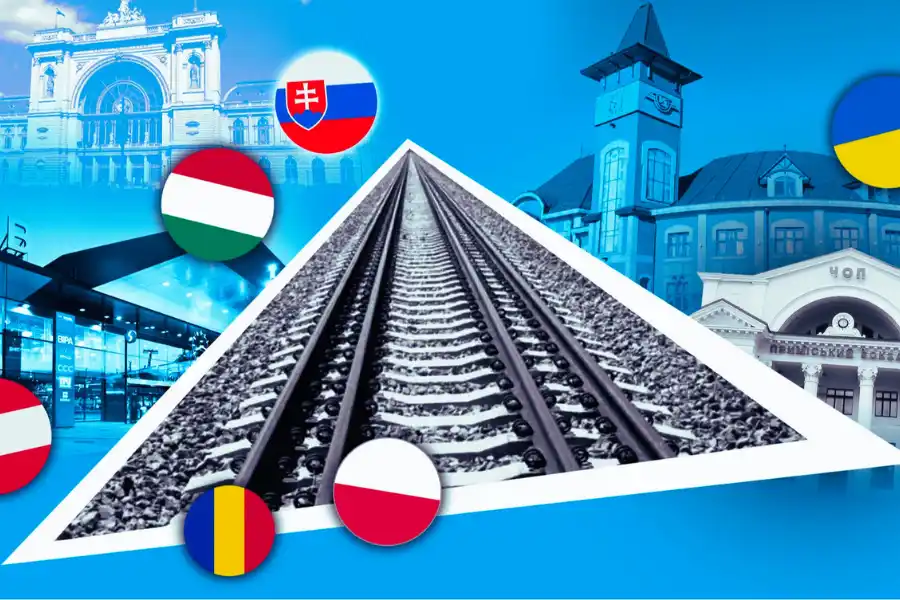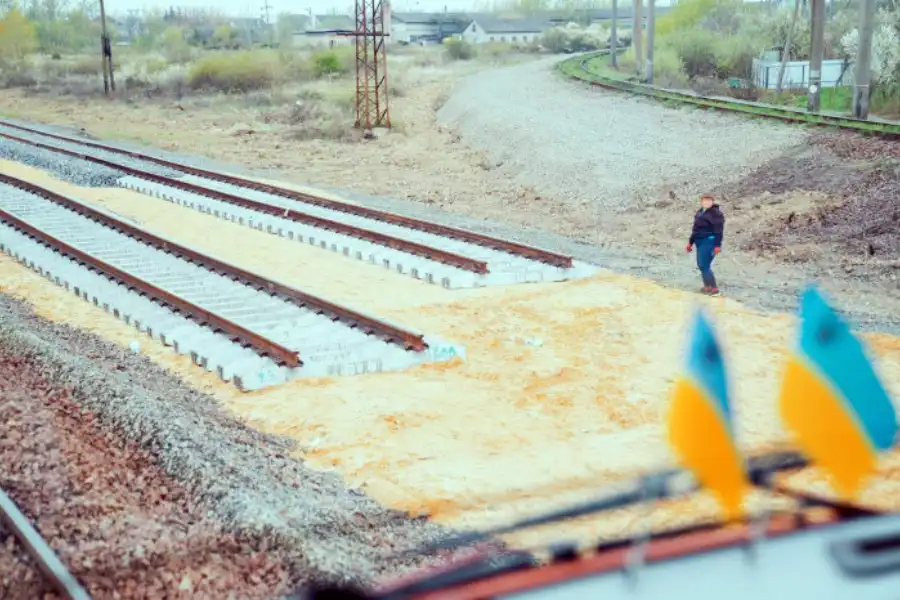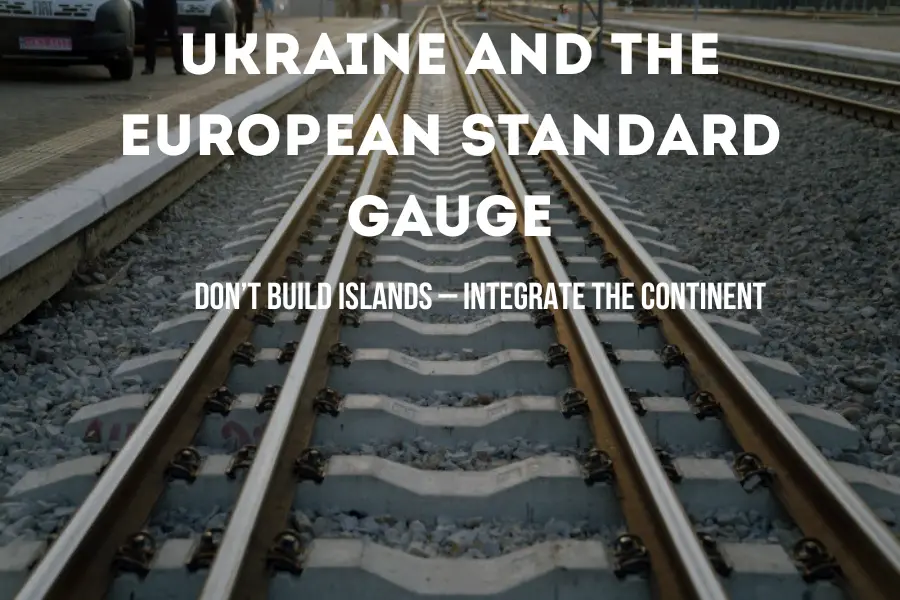Ukraine and the European Standard Gauge: Don’t Build Islands – Integrate the Continent
Denys Kostrzhevskyi, Chair of the Board of Kyiv International Airport, expert in public–private partnerships
A lively debate is growing in Ukraine: do we need the European-standard gauge — and if so, what form should it take?
Some argue for a wholesale conversion of the entire country to the European standard.
Others insist that such an undertaking would be too costly and simply unrealistic.
As usual, the truth lies somewhere in between.
I am convinced the greatest mistake would be to build a separate, “island” network of European-gauge rail, cut off from the existing one — as if creating a new country inside the old.
The right approach is not to copy Poland or Germany but to create a hybrid system:
key export and military corridors on 1,435 mm gauge, the domestic network remaining on 1,520 mm, and transitional terminals acting as points of integration, not barriers.
Otherwise we risk building yet another infrastructure “island” that will cost three times as much to operate and fail to deliver the expected benefits.
Who Opposes It — and Why They Keep Quiet
Opposition to the European-gauge network does not come from “Soviet nostalgics” or traitors.
It comes from those who profit from the current arrangement.
Whole sectors live off the difference between 1,520 mm and the European 1,435 mm gauge:
specialised repair plants; locomotive manufacturers whose rolling stock never runs beyond Chernivtsi; and logistics firms that earn on every trans-shipment.
Ukraine now spends up to $150 million a year merely on re-loading grain at the EU border.
Those are not national expenses — they are someone’s income.
European-gauge rail threatens these businesses.
That is why resistance will appear — not openly, but covertly, under the guise of “expert opinions”, “environmental concerns” or claims of “unprepared infrastructure”.
The issue is not technical — it is financial.

Corruption Fears Standards
When you operate a unique local standard, you control suppliers, prices, maintenance and certification.
That is fertile ground for schemes.
In Ukraine, over 70 per cent of railway procurement is conducted in closed tenders without international competition.
European gauge would open this market: European suppliers, international standards, independent audit.
That means fewer slush funds, fewer “insiders”, fewer opportunities for rent-seeking.
The real resistance therefore lies not in technical arguments but in vested financial interests.
The Money Question: Railways Should Be Built by the Private Sector
A large-scale reform to integrate the European gauge is not a project for Ukrainian Railways in its present form.
It is a project for concessions and international investors.
The state must do one thing:
set clear rules, protect the process from corruption, provide guarantees and safeguard investments.
Building, operating and maintaining must be entrusted to professionals —
as in Poland, where European-gauge projects are being built in partnership with DB (Germany), PKP Cargo and private operators.
What We Already Have — and Why It Is Not Enough
Chop–Uzhhorod Section (22–24 km) — Opened September 2025
Pros:
- The first practical case proving that European-gauge track can be laid on Ukrainian territory even in current conditions.
- Offers technical potential to connect with the networks of Slovakia, Hungary and Romania, and to run through-trains without changing bogies at the border.
Cons:
- Very short — it does not create a full corridor.
- Lacks a proper system of transitional terminals and hubs.
- Rolling stock for 1,435 mm is still insufficient.
Sknyliv (near Lviv) – Mostyska II (Polish border) — EU-Funded Project (2025)
In July 2025 the EU allocated €76 million for the first stage of the Sknyliv–Mostyska II section to connect Lviv to Poland via European-gauge rail.
Pros:
- A strategically important corridor linking Lviv directly to the EU’s TEN-T network.
- Provides for terminals and hubs — laying the groundwork for real integration.
Cons:
- Still at an early, design stage; no operational corridor yet.
- High cost and complexity: needs terminals, new rolling stock, and coordination with Poland.
- Without extension deeper into Ukraine, risks becoming a short fragment rather than a functioning route.
Local / Historic Initiatives (Mukachevo and Border Hubs)
For example, a European-gauge platform was built in Mukachevo to run international services to Budapest.
These were point solutions for passengers, not systemic network expansion.
Pros:
- Gave quick operational experience with boarding/alighting for international trains.
- Allowed fast launch of selected cross-border services.
Cons:
- A point solution with no systemic effect.
- Minimal economic return because of the lack of multimodal terminals and logistics integration.
Ukraine has thus made its first steps:
the short Chop–Uzhhorod section is in service, and the Sknyliv–Mostyska project has secured EU funding.
Yet these lines do not form a coherent network.
They are more symbolic demonstrations of potential than providers of systemic effect.
Without consistent corridor development and the creation of transitional hubs, each section remains a “shop window” only.
It is like building an airport without roads leading to it.
We create infrastructural “dead zones” instead of a strategic network.
Europe Is Not Waiting — It Is Building
Look at the EU’s TEN-T transport network.
It is already integrating Poland, the Baltic States and Romania.
In 2023 the EU allocated over €5 billion for the development of rail corridors in Eastern Europe.
The condition is standardisation.
Anyone who fails to switch to the European gauge by 2030 will be left outside the system —
not as a partner but as a transit bottleneck.
Finland, which like Ukraine uses broad gauge (1,524 mm), has long had effective transition terminals with Sweden and Russia.
Romania is integrating European-gauge lines not as a separate project but as part of a national strategy.
And we still debate whether the rails are “worth the money”.
European Gauge in Ukraine: Symbol versus Economics
The European gauge certainly carries symbolic meaning —
it is a sign of integration, of Ukraine’s return to the European space.
But behind the attractive symbol lies hard economics.
Infrastructure, unlike flags and slogans, does not forgive illusions.
It either drives national development or becomes dead capital, draining resources.
We must treat the gauge question pragmatically.
Arguments For
- Removing the “rail border”.
Every freight consignment or passenger train heading west today has to undergo complicated trans-shipment or change-of-gauge.
That wastes time and adds costs — ultimately increasing the price of Ukrainian goods.
European-gauge rail removes this obstacle. - Attracting investment.
Companies operating in the EU will see Ukraine’s infrastructure as compatible and therefore reliable —
a strong argument in the competition for manufacturing sites, logistics hubs and transport routes. - Passenger services.
Imagine a direct high-speed Kyiv–Warsaw or Kyiv–Berlin train without a change.
This is not just convenience for travellers but a signal that Ukraine truly belongs to the European space.
Arguments Against
- High cost.
A mass conversion would require tens of billions of euros.
Ukraine’s budget cannot afford it; nor are international partners yet ready to cover the gap —
though this could be partly offset by well-designed concessions and public–private partnerships. - Time.
Even with funding, converting the entire network would take decades —
disrupting logistics and causing losses for business. - Rolling stock.
Our locomotives and wagons are built for 1,520 mm.
They cannot be changed overnight.
During the transition we would have to maintain two parallel systems, adding to costs. - Geography.
Most domestic traffic moves within the country, and the main freight corridors go south and east.
For them, the European gauge is not critical.
We could spend colossal sums and fail to achieve commensurate benefits.

Lessons from Other Countries
Take Poland’s Broad-Gauge Metallurgy Line (LHS) —
400 km of Soviet-standard track laid inside the EU to facilitate Ukrainian freight.
Poland did not “re-gauge” the country — it integrated another standard because it made economic sense.
Or look at Rail Baltica, the ambitious European-gauge project through Lithuania, Latvia and Estonia.
The concept is attractive, but the problems are many:
costs near €6 billion, repeated delays, and above all the need to maintain two parallel systems.
And that is in small countries — Ukraine’s challenge would be far greater.
Slovakia, the Czech Republic and Hungary have followed mixed approaches:
building selected European-gauge lines while keeping broad gauge where it is economically advantageous.
The lesson: the challenge is not to “re-gauge” an entire country but to integrate standards intelligently.
The Only Way Forward — Start with a Hybrid Strategy
We should not wait for a “perfect plan”.
We should launch a pilot hybrid network:
- Kyiv–Lviv–Kraków on European gauge;
- Odesa–Constanța, with a modernised terminal in Izmail as a southern vector towards the Black Sea ports;
- Kharkiv–Lublin as a nationwide logistics corridor.
Each of these routes must be linked to the domestic network.
The solution is transitional hubs and terminals.
This is not fantasy:
technologies exist for variable-gauge rolling stock and for rapid container trans-shipment.
Such solutions are more expensive at the start but save billions by avoiding total re-gauge conversion.
Otherwise we risk another “island”.
We need European-gauge trunk lines on key international routes —
that is where the greatest effect will come:
faster freight and passenger traffic, more investment, new routes for business.
Meanwhile the domestic network should remain at 1,520 mm.
It is our economic backbone, carrying ore, grain and steel — the bulk of GDP.
Converting these flows to European gauge would be senseless and prohibitively expensive.
European Gauge — a Responsible Strategic Choice
European-gauge rail in Ukraine is not about romantic symbolism but about hard calculation —
an investment in the future that must pay off.
We must not chase slogans or blindly copy foreign models.
Our path is a hybrid system:
key corridors on the European gauge, the domestic network on 1,520 mm, with modern transitional hubs.
Only in this way will we avoid the trap of isolation, evade unbearable costs and maintain efficiency.
European-gauge rail for Ukraine is not only economics but also geopolitics.
Every kilometre of European track is a kilometre of integration —
but the choice must be made wisely.
If we build an “island” network, we will gain the symbol but not the result.
If we integrate the European standard into our own system, we will gain both the symbol and the real benefit.
We have already lost 30 years.
Europe will not wait another ten.
If we keep building isolated stretches without a strategy, we will end up with expensive but useless infrastructure —
and lose the chance to become part of the European economy.
European-gauge rail is not just about the rails.
It is about a strategic choice: to build islands or to integrate the continent.
And the choice must be made now.
Denys Kostrzhevskyi, Chair of the Board of Kyiv International Airport, expert in public–private partnerships.
